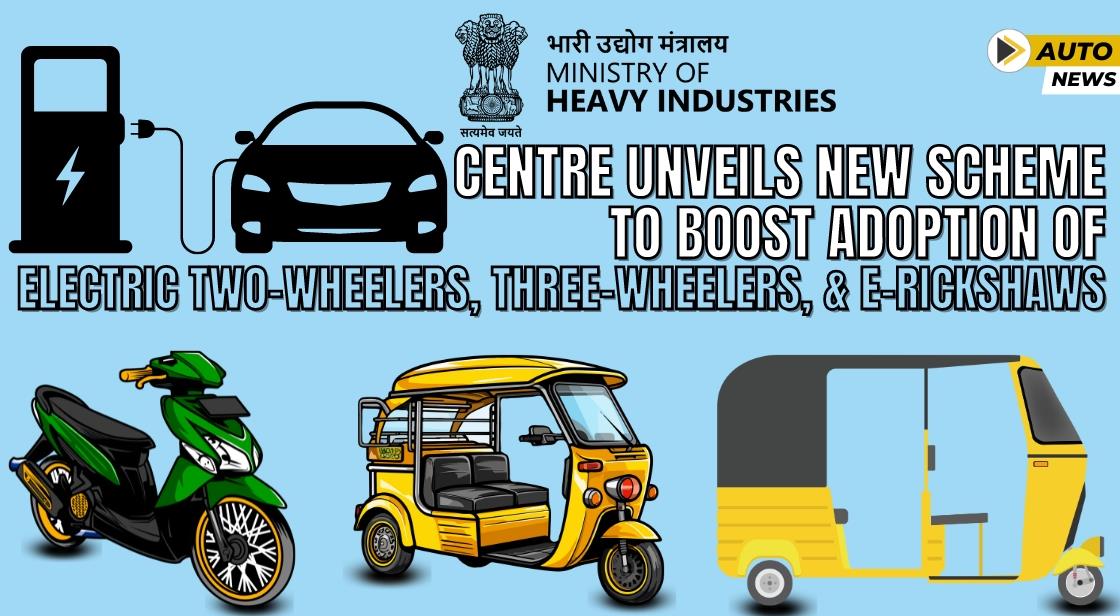Centre Unveils New Scheme to Boost Adoption of Electric Two-Wheelers, Three-Wheelers, and E-Rickshaws

News Synopsis
The Centre announced a significant initiative aimed at accelerating the adoption of electric vehicles (EVs) in India. The Electric Mobility Promotion Scheme (EMPS), 2024, unveiled by Heavy Industries Minister Mahendra Nath Pandey, seeks to promote the sales of electric two and three-wheelers. With an allocated budget of Rs 500 crore, this scheme is poised to make a substantial impact on the EV market.
Details of the Electric Mobility Promotion Scheme (EMPS), 2024:
The Electric Mobility Promotion Scheme (EMPS), 2024, is set to commence on April 1, with a duration of four months. Here are the key highlights of the scheme:
Incentive Structure:
-
Electric Two-Wheelers (e2w): A total of 3.37 lakh units are eligible for incentives, with Rs 5000 per KWH, capped at Rs 10000.
-
Electric Three-Wheelers (e3w): Approximately 41306 units qualify for incentives, with Rs 5000 per KWH, capped at Rs 25000.
-
Electric Rickshaws (e-ricks): Around 13590 units are eligible for incentives, with Rs 5000 per KWH, capped at Rs 25000.
-
Large Electric Three-Wheelers (L5 e3w): With 25238 units in scope, the incentive stands at Rs 5000 per KWH, capped at Rs 50000.
Clarification on FAME-II Scheme:
Contrary to recent reports suggesting an extension of the FAME-II scheme, the Ministry of Heavy Industries clarified that there has been no such extension. The flagship scheme, which aimed to boost EV adoption, was initially set to conclude on March 31. However, the government has not granted a temporary four-month extension to the scheme, denying the reports.
Continuation of FAME-II Subsidies:
The Ministry of Heavy Industries had previously announced that subsidies under the FAME-II scheme would remain applicable for EVs sold until March 31, 2024, or until the funds are exhausted. Moreover, the outlay for the FAME-II program has been increased from Rs 10,000 crore to Rs 11,500 crore, reflecting the government's commitment to promoting sustainable mobility.
Revised Incentive Structure:
Under the new EMPS, the incentive for electric two-wheelers (e2w) has been reduced from Rs 22,500 to Rs 10,000. Similarly, incentives for electric three-wheelers (e3w) have been set at Rs 25,000 for e-rickshaws and Rs 50,000 for e3w with a higher battery capacity.
Incentive Structure at a glance
|
Vehicle Type |
Target Quantity |
Incentive (per kWh) |
Maximum Cap |
|
Electric Two-Wheelers (e2w) |
3.37,000 |
Rs 5,000 |
Rs 10,000 |
|
Electric Three-Wheelers (e3w) |
41,306 |
Rs 5,000 |
Rs 25,000 |
|
Electric Rickshaws (e-rickshaws) |
13,590 |
Rs 5,000 |
Rs 25,000 |
|
Large Electric Three-Wheelers (L5 e3w) |
25,238 |
Rs 5,000 |
Rs 50,000 |
Impact of FAME-II Scheme:
Launched in 2019, the FAME-II scheme has played a pivotal role in incentivizing EV adoption across the country. Government data indicates that subsidies have been provided for nearly 1.2 million two-wheelers, 141,000 three-wheelers, and 16,991 four-wheelers under the scheme. With a disbursement of over Rs 5,829 crore, FAME-II has significantly contributed to the growth of the EV ecosystem in India.
Key Points
-
This scheme replaces the FAME-II program, which ended on March 31, 2024.
-
The government clarified there is no four-month extension for FAME-II.
-
EMPS 2024 offers a reduced incentive compared to FAME-II for e2w (Rs 10,000 vs. Rs 22,500).
-
The scheme aims to support the continued adoption of electric vehicles in India.
Conclusion:
The unveiling of the Electric Mobility Promotion Scheme (EMPS), 2024, underscores the government's steadfast commitment to promoting sustainable mobility solutions and reducing carbon emissions. By incentivizing the adoption of electric two and three-wheelers, the scheme aims to accelerate India's transition towards a cleaner and greener future.









